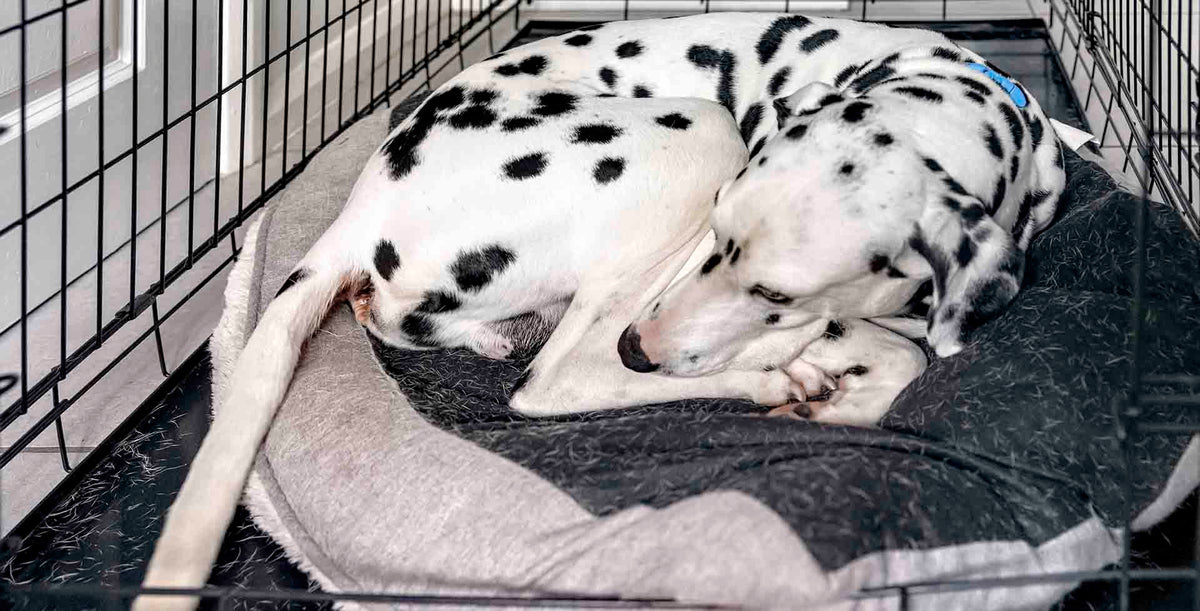
Crate Training 101
|
|
Time to read 4 min
|
|
Time to read 4 min
To crate train, or not to crate train? That is the question. If you've raised a dog before, you know the immense importance of utilizing a crate for various purposes. From effectively potty training your furry companion to safeguard your home from potential destruction while you're away, the advantages are evident.
However, if you've never had a dog, especially a puppy, you might hold the misconception that confining them in a small cage is cruel or inhumane. In reality, crate training is far from barbaric; it's a compassionate approach to ensure your dog's safety, comfort, and well-being.
Dogs view their crates as a safe and comfortable place to call their own. So much so, even when you leave the door open, you’ll often find your pooch hanging out in its metal doggy den. Caninejournal.com reminds us where dogs come from. “In the wild, a dog’s den is their home, a safe space where he can sleep, retreat, and raise pups without fear of danger, without outside threat.”
It’s best to introduce your pup to the crate as soon as possible. Crate training is not stress-free but there are steps you can take to make it as smooth as possible.
If you’ve decided to crate train, stay dedicated no matter what. When you hear your pup crying and whining, don’t give in and don’t give up. You may feel like you’re rescuing it from being sad and lonely, however, you’re not rescuing it from anything. Instead, you’re actually creating problems for you both.
With consistent training, you and your dog will learn to love the crate.
Dogs grow quickly. Purchase a crate with a divider so it can grow with your dog. This divider can create the perfect space for a puppy and ensure it’s not cramped as it matures. Dogster.com says, “The ideal size crate will be large enough for your dog to comfortably stand, sit, stretch, turn around, and lay down.”
You never want to use the crate as punishment. Your dog had an accident so put it in the crate. WRONG! Your dog ate your shoe so put it in the crate. WRONG! Your dog is barking so put it in the crate. WRONG! Establishing a positive connection to the crate will make crate training a whole lot easier for everyone.
A crate is an excellent tool to successfully potty train your pup. A dog’s den, as mentioned above, is a very special place and one that no dog wants to soil. You know the saying, “Don’t sh*t where you eat?” That applies here. This doesn't mean you won’t be cleaning up messes in the crate because it does happen. Your dog can only hold its bladder for so long.
Most pet owners will put their dog in a crate to ensure their house doesn’t get wrecked while they’re not home. Your items are precious to you and puppies can get into anything and everything. Exactly. It’s also about protecting your pet. If your dog accidentally found the cleaning supplies while you’re out and about, there could be horrible consequences.
A crate protects everyone and everything in the house when you can’t control the environment.
What does a crate have to do with grooming? Many groomers will put your dog in a crate before or after grooming to keep all the dogs safe. Grooming can be scary enough for dogs. Add in a crate that’s unfamiliar territory and you may have to learn how to groom your dog yourself.
You already know a crate can lessen the chances of your dog having accidents while in it. A crate also teaches your dog what to do when not in the crate.
When that door opens, and you head outside, your dog will know relieving itself is the number one (or number two) priority. It will know where to go instead of choosing its own spot inside when roaming around.
If your pup’s roaming around the house and you miss an accident, you also missed the opportunity to correct the bad behavior.
When a crate’s involved, it gives you more control and helps your dog gain control of its bladder.
As your dog matures and spends less time in the crate, that trust will have already been built. No matter how old your dog is, always be consistent with potty time and praise. Using your special potty word and demonstrating positive reinforcement will keep up the routine.
This all sounds amazing, but now what? Some dogs will love their crate right away, while others will take a little longer to appreciate what it has to offer. Along with suggestions from The Humane Society of the United States, below is a list of quick tips to start you and your dog off on the right paw. (Can I get a chuckle?)
A crate has so many benefits for dogs of all ages. It also has tremendous benefits for owners including fewer messes to clean up, better supervision, and a faster potty training process. Don’t you wish you had a crate that you could escape to? I believe that’s what you call a She Shed. I’ll take it!


